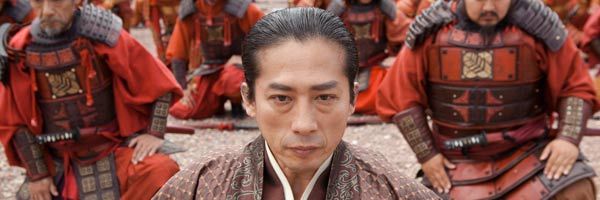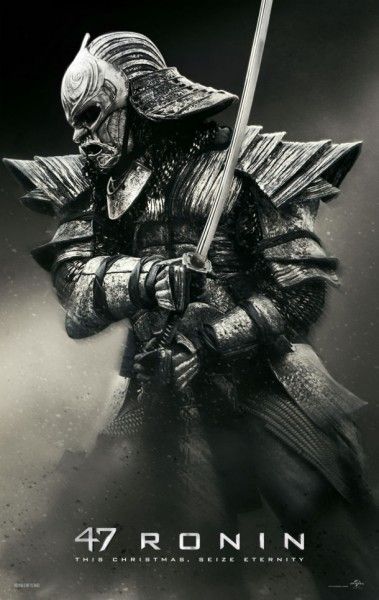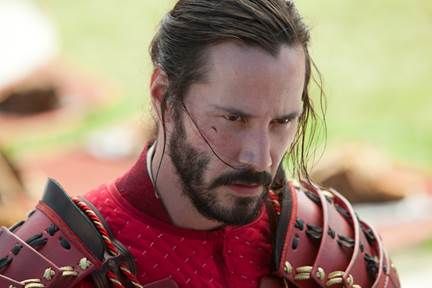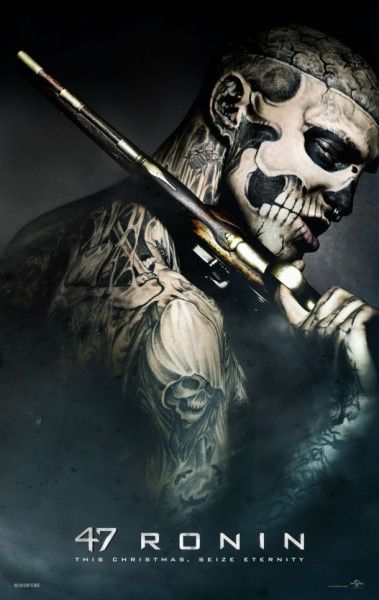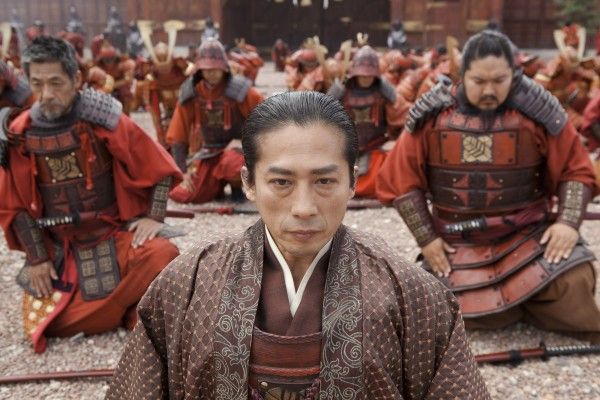During a group interview on the set of 47 Ronin, Hiroyuki Sanada explained why he wanted to be in the film:
"This is almost the most famous story – Samurai story – in Japan. But we have a lot of original stuff in the script so we changed a lot, taking it in a fantasy way. It’s a very special movie for me. Not only a Samurai thing. Not only a Hollywood fantasy. It has a very special mixture between Japanese traditional culture and Western culture for the costume, set, story. Everything. I believe it will be a very special film that no one has ever seen."
He also talked about what the story of the 47 Ronin means to him, how making this film compares to The Last Samurai, what it's been like filming in 3D, the choreography and action, the costumes, and much more. Hit the jump for what he had to say.
Before going any further, if you haven't seen the latest 47 Ronin trailer, I'd watch that first:
Question: What was the big draw about doing this movie?
HIROYUKI SANADA: This is almost the most famous story – Samurai story – in Japan. But we have a lot of original stuff in the script so we changed a lot, taking it in a fantasy way. It’s a very special movie for me. Not only a Samurai thing. Not only a Hollywood fantasy. It has a very special mixture between Japanese traditional culture and Western culture for the costume, set, story. Everything. I believe it will be a very special film that no one has ever seen.
Were you a little bit nervous about the fantasy element that has been added to the story?
SANADA: At the beginning, yes. When I heard the story before I met Carl and producers. But when I met him, we talked a lot about the cultural things, the image of the film, and I could believe because he has a great sense visually and also he respects our culture. Also, he has a good balance between the visual and the drama and action, so I thought if he’s going to direct, we can make a new, epic film. My fear was gone when I met him.
How old were you when you first heard the story of Ronin and what does it mean to you?
SANADA: When I was eight or nine years old, I saw the TV version of 47 Ronin, played by Toshiro Mifune. He played Oishi. That was my first experience. I watched every week with my brother. “Who plays Oishi tonight? Who will play Kira tonight?” And we fought every week. After that, I saw a lot of 47 Ronin on the TV, in the films, and I’ve done Chushingura Gaiden Yotsuya Kaidan [Crest of Betrayal, 1994] directed by Kinji Fukasaku. So this is my second time doing 47 Ronin.
What did you think about the addition, when Oishi is traditionally the main character?
SANADA: It’s a good way to make an international film. It’s only Japanese film, only Japanese cast, it’s very difficult to introduce the world to our culture. It’s a very special situation. A lot of episodes have gone from the original, but a lot new ideas have come in. So I believe because his character is there we can introduce our culture to the world. So it’s very welcome for me.
You starred in The Last Samurai. How has this experience been different?
SANADA: We’ve shot in Japan. I’ve done Last Samurai in Japan, in LA, in New Zealand. But we created at the whole village in New Zealand. London. Budapest. I feel like it’s the same. Even in Japan it is very hard to shoot, because there’s been so many changes. Only around a temple can we shoot. The city is completely different – too modern. So even if we made the film in Japan, we would have to create sets, like this, from the beginning. So we can do that anywhere.
Keanu has absorbed himself into the culture. What do you think of that?
SANADA: He’s learned a lot, respecting the culture. I was surprised when I first met him. He knew a lot already and he learned a lot. And also he learned Japanese. It’s incredible. On the set, switching between the Japanese and English, even for us, is very hard. It’s complicated. But the first time Keanu spoke in Japanese it was a very important scene between us, and more than the dialogue’s meaning, I was moved. His energy for the film, completely perfect Japanese pronunciation. It was moving, surprising, respecting. Another emotion coming to mind. And from that moment, we were getting closer and the wall is gone. The wall meaning walls of dialogue, language, or colour, or religions, a lot of walls have gone. That is one of great part of Carl’s direction this time. I think it’s very hard to direct foreign language actors, but he found a great way. A special super visional way.
How have you found shooting in 3D?
SANADA: Completely my first time. I was so excited. When i’ve done camera test, after we’ve shot and I’ve seen the monitor with the glasses (wearing a Kimono) and looking by myself in 3D. Oh my god. Especially for a Samurai film. I’ve never seen that. It’s kind of a culture shock. I was a child actor, so when I started filming when I was five years old, it was a long time ago. It was a black and white film. And then it changed to colour film, and I was surprised and culture shocked when I was six or seven years old. And then HD, then 3D now. So what’s going? What’s coming next? It’s so exciting.
Does shooting in 3D present a big challenge for the actors?
SANADA: Basically the same. I thought it would take longer to shoot or be harder. But it’s completely the same. The camera is just like a normal camera for us. I feel like there’s no difference from an ordinary film. It was very smooth, more than you would imagine. How can we use 3D? The full length. Give the film more excitement. What kind of movement would work for 3D and be more exciting? Especially for the fight scenes. You know the sword coming towards the lens means the audience will feel like it will cut them.
Is there anything special about the choreography being used?
SANADA: I’ve done a lot of Samurai film in Japan before, and sometimes done the choreography by myself. There’s a great choreographer on set. Sometimes it’s Hong Kong style all mixing. We tried to make a contrast between Keanu’s special skills – taught from the monsters – and traditional Samurai style. We try to make differences at the beginning.
Has anything been done to the choreography to distinguish Keanu’s style?
SANADA: The peaceful period in Japan – the Edo period is so peaceful. Even the Samurai were learning sword fighting in the schools, never fighting in real-life. But Keanu’s character had to survive, had to kill someone to survive. At the beginning even the samurai have never killed anybody before in real life. We can learn from Keanu’s characters. No rules in real fights, so you have to use everything.
Are you used to wearing period clothing?
SANADA: Very comfortable. I’ve been wearing kimono for several years, and armor. Especially for this film there’s a nice mixture between western and eastern. So Ronin wearing the boots, like Western style. It’s a nice mixture. At the beginning we discussed a lot. How traditional? How Westernised? It’s a Samurai story, so if we change too much Japanese audiences will have strong against feelings to the film. It’s not good. So they will enjoy and understand. But also to the world market – from the child to the old guys. Let’s find out the best way, the best mixture for each part – costume, props, set, fighting style, acting. So everyday, every single thing is discussed.
World audiences, but we want to keep our culture. So always arguing, fighting, to find out the best way. Until final moment, we’re discussing a lot. This is a good thing, mixing culture to make something new, something no one has ever seen. This is kind of a new history. Especially for us. A lot of country making films in English, but in Japan we are very shy to speak English. Very shy. But Spanish movie, Indian movie, now we should open the gate to the world, I believe, the Japanese film industry must be open. This is the right time. I am glad to be here to create a new history in our industry. I’m very proud of this.
Here's more from my 47 Ronin set visit:
- 47 RONIN Set Visit with Video Blog Recap
- Keanu Reeves Talks the Film's Action Sequences and Effects, Working in 3D, and More on the Set of 47 RONIN
- Director Carl Rinsch Talks His Approach to 3D, Making His Directorial Debut on a Big Tentpole, Not Changing the Original Ending, and More on the Set of 47 RONIN
- Costume Designer Penny Rose Talks Designing Samurai, Working with CGI Characters, and More on the Set of 47 RONIN

